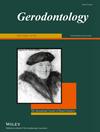Mini-implant mandibular overdentures under a two-step immediate loading protocol: A 4–6-year retrospective study
IF 2
3区 医学
Q2 DENTISTRY, ORAL SURGERY & MEDICINE
引用次数: 1
Abstract
OBJECTIVES This retrospective study to evaluate the treatment outcomes of mandibular mini-implant overdentures (MIODs) placed under a two-step immediate loading protocol. BACKGROUND The mini-implant overdenture emphasises the advantages of simplicity using flapless surgery and immediate loading. However, some mini-implant have lowe initial stability. MATERIALS AND METHODS A total of 30 participants who used mandibular MIODs and maxillary removable complete dentures (RCDs) over 4 years were included. Four one-piece mini-implants (<3 mm in diameter) were placed by a flapless surgical approach after fabrication of new RCDs, and the O-ring attachment was attached at least 8 weeks after implant placement. RESULTS The average observation period was 58.9 ± 9.2 months after mini-implant loading. The survival rate of the implants was 100.0%, and the overall change in mean marginal bone level (ΔMBL) was -0.9 ± 1.1 mm. The implant success rate was 83.3% at the implant level, and 66.7% at the patient level. The mean initial Periotest value was 0.9 ± 3.1, and it was positively associated with ΔMBL and implant success (P < .05). Patient satisfaction improved after conversion from RCDs to MIODs (P < .05), and mastication and pain showed greater satisfaction with longer loading time (P < .05). CONCLUSIONS The mandibular MIODs could be chosen as an alternative treatment under a two-step immediate-loading protocol in edentulous patients with limited alveolar bone volume. To ensure superior treatment outcomes of MIODs, initial stability of implant must be obtained using as wide a diameter as possible within the anatomically allowable limits.两步即刻装填方案下的微型种植下颌覆盖义齿:一项4-6年回顾性研究。
目的:本回顾性研究评估下颌微型种植覆盖义齿(MIODs)在两步即刻加载方案下的治疗效果。背景:微型种植覆盖义齿强调无瓣手术简单、即刻装填的优点。然而,一些微型植入物的初始稳定性较低。材料和方法:共纳入30例使用下颌MIODs和上颌可摘全口义齿(rcd)超过4年的患者。结果:植入微型种植体后,平均观察时间为58.9±9.2个月。种植体成活率为100.0%,平均边缘骨水平总体变化(ΔMBL)为-0.9±1.1 mm。种植体水平的种植成功率为83.3%,患者水平的种植成功率为66.7%。平均初始Periotest值为0.9±3.1,与ΔMBL和种植体成功呈正相关(P结论:对于牙槽骨容量有限的无牙患者,下颌MIODs可作为两步立即加载方案的替代治疗方法。为了确保MIODs的良好治疗效果,必须在解剖学允许的范围内使用尽可能宽的直径获得种植体的初始稳定性。
本文章由计算机程序翻译,如有差异,请以英文原文为准。
求助全文
约1分钟内获得全文
求助全文
来源期刊

Gerodontology
医学-老年医学
CiteScore
4.10
自引率
10.00%
发文量
50
审稿时长
3-6 weeks
期刊介绍:
The ultimate aim of Gerodontology is to improve the quality of life and oral health of older people. The boundaries of most conventional dental specialties must be repeatedly crossed to provide optimal dental care for older people. In addition, management of other health problems impacts on dental care and clinicians need knowledge in these numerous overlapping areas. Bringing together these diverse topics within one journal serves clinicians who are seeking to read and to publish papers across a broad spectrum of specialties. This journal provides the juxtaposition of papers from traditional specialties but which share this patient-centred interest, providing a synergy that serves progress in the subject of gerodontology.
 求助内容:
求助内容: 应助结果提醒方式:
应助结果提醒方式:


